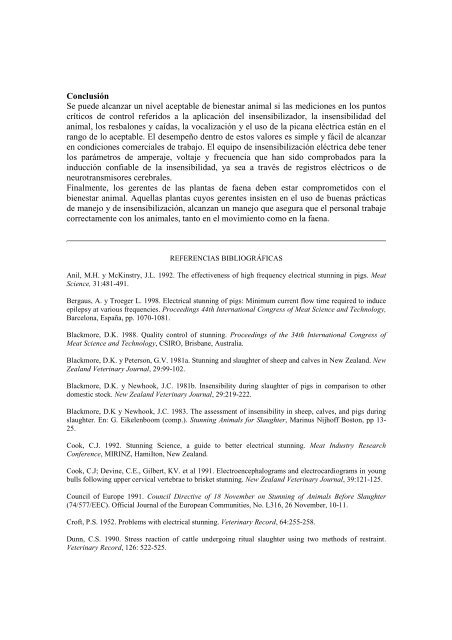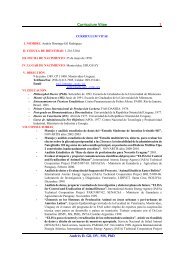TRADUCCION DE ARTICULOS SELECCIONADOS - Bienestar Animal
TRADUCCION DE ARTICULOS SELECCIONADOS - Bienestar Animal
TRADUCCION DE ARTICULOS SELECCIONADOS - Bienestar Animal
Create successful ePaper yourself
Turn your PDF publications into a flip-book with our unique Google optimized e-Paper software.
Conclusión<br />
Se puede alcanzar un nivel aceptable de bienestar animal si las mediciones en los puntos<br />
críticos de control referidos a la aplicación del insensibilizador, la insensibilidad del<br />
animal, los resbalones y caídas, la vocalización y el uso de la picana eléctrica están en el<br />
rango de lo aceptable. El desempeño dentro de estos valores es simple y fácil de alcanzar<br />
en condiciones comerciales de trabajo. El equipo de insensibilización eléctrica debe tener<br />
los parámetros de amperaje, voltaje y frecuencia que han sido comprobados para la<br />
inducción confiable de la insensibilidad, ya sea a través de registros eléctricos o de<br />
neurotransmisores cerebrales.<br />
Finalmente, los gerentes de las plantas de faena deben estar comprometidos con el<br />
bienestar animal. Aquellas plantas cuyos gerentes insisten en el uso de buenas prácticas<br />
de manejo y de insensibilización, alcanzan un manejo que asegura que el personal trabaje<br />
correctamente con los animales, tanto en el movimiento como en la faena.<br />
REFERENCIAS BIBLIOGRÁFICAS<br />
Anil, M.H. y McKinstry, J.L. 1992. The effectiveness of high frequency electrical stunning in pigs. Meat<br />
Science, 31:481-491.<br />
Bergaus, A. y Troeger L. 1998. Electrical stunning of pigs: Minimum current flow time required to induce<br />
epilepsy at various frequencies. Proceedings 44th International Congress of Meat Science and Technology,<br />
Barcelona, España, pp. 1070-1081.<br />
Blackmore, D.K. 1988. Quality control of stunning. Proceedings of the 34th International Congress of<br />
Meat Science and Technology, CSIRO, Brisbane, Australia.<br />
Blackmore, D.K. y Peterson, G.V. 1981a. Stunning and slaughter of sheep and calves in New Zealand. New<br />
Zealand Veterinary Journal, 29:99-102.<br />
Blackmore, D.K. y Newhook, J.C. 1981b. Insensibility during slaughter of pigs in comparison to other<br />
domestic stock. New Zealand Veterinary Journal, 29:219-222.<br />
Blackmore, D.K y Newhook, J.C. 1983. The assessment of insensibility in sheep, calves, and pigs during<br />
slaughter. En: G. Eikelenboom (comp.). Stunning <strong>Animal</strong>s for Slaughter, Marinus Nijhoff Boston, pp 13-<br />
25.<br />
Cook, C.J. 1992. Stunning Science, a guide to better electrical stunning. Meat Industry Research<br />
Conference, MIRINZ, HamiIton, New Zealand.<br />
Cook, C.J; Devine, C.E., Gilbert, KV. et al 1991. Electroencephalograms and electrocardiograms in young<br />
bulls following upper cervical vertebrae to brisket stunning. New Zealand Veterinary Journal, 39:121-125.<br />
Council of Europe 1991. Council Directive of 18 November on Stunning of <strong>Animal</strong>s Before Slaughter<br />
(74/577/EEC). Official Journal of the European Communities, No. L316, 26 November, 10-11.<br />
Croft, P.S. 1952. Problems with electrical stunning. Veterinary Record, 64:255-258.<br />
Dunn, C.S. 1990. Stress reaction of cattle undergoing ritual slaughter using two methods of restraint.<br />
Veterinary Record, 126: 522-525.





